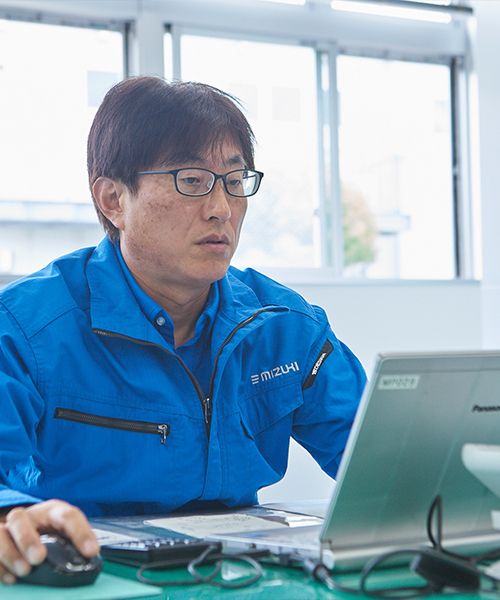
STORY#03
In recent years, production base of Japanese manufacturing industry has gradually shifted away from Japan to China and Southeast Asia. The production base change has caused a considerable influence on Japan’s SMEs. The SMEs will be facing many barriers, such as differences in languages and business customs, when dealing with companies that have moved the production base overseas. Especially the aspect associated with quality assurance, specialized knowledge is necessary to accommodate the quality assurance. Mr. Toshihiko Takanashi, Environmental Quality Assurance Group Leader in Management Department tells how Mizuki corresponds to the global market in quality assurance.
Quality Assurance Corresponding to the Overseas Transaction

There are a wide range of procedures involved with quality assurance, such as acceptance inspection, shipping inspection, etc. In trading with overseas、what has become important is the submission of quality assurance documents in English.
Many documents are required in business. There are quite a few SMEs that gave up business transactions because they were not able to submit required documents.
“The major document required from overseas is English version of the environment information, such as RoHS, REACH, ConFlict Mineral. We, Mizuki, are capable of providing quality assurance data and documents for those environment information needed,” Mr. Takanashi said.
Mr. Takanashi went on to note that since many of Mizuki’s customers, with production-base in China and Southeast Asia, intend to export the final products to the United States and/or Europe, submission of the RoHS or REACH becomes essential.
“For instance, analysis data called ICP is necessary for RoHS, at Mizuki we utilize the network of analysis laboratories overseas to analyze all components properly, so we are able to prepare the documents smoothly”
Know-how of Cumulative Documentation

After all, there is know-how in the preparation of quality assurance documents. Even those who are fluent in English will likely be daunted when facing many technical English documents.
“Technical English is very difficult. There were lots of terms we didn’t know at the beginning.”
For instance, there are many words which not listed on the dictionaries, such that “O.D” means “outer diameter” and “I.D” means “inner diameter.” At Mizuki, when there is a new word for the staff, they ask their customers or find out themselves every time. Consequently, each staff has deepened the knowledge in technical English. Additionally, accumulation of knowledge is fulfilled in the boilerplate e-mail exchanges with customers overseas. That’s the process how Mizuki handles the technical documents.
In addition, there are fine mechanical or technical nuances which are difficult to be explained in English. For those parts, when necessary, “drawings” and “photos” are used as much as possible for intricate description. The staff devises methods to make them visual and easy to understand.
In addition, Mizuki pays attention to the “world standard” rather than the so-called “Japanese style”.
“For instance, in a report, the Japanese writing style is that ‘result’ comes after ‘explanation,’ while in worldwide style is that ‘result’ comes first and ‘description’ comes after. Knowledge of English is, of course, necessary, but we are also concerning about what the customers are requesting, as well as not to cause a feeling of strangeness for overseas customers by providing them easy-understanding reports.”
Raising Customer Satisfaction by a Speedy Response

Speed is required to respond to foreign companies. Because there are suppliers involved in until a final product is completed, the more downstream suppliers a company has, the longer production time lag occurs. Therefore, delivery date management becomes difficult. To avoid such time lag, Mr. Takanashi often directly phone abroad in case of an emergency.
“Direct talk to the customers to make a rapid response is very important, and besides, it is possible to build a trust relationship by the direct communication.”
Mizuki realizes there are customers ahead of the customer. By keeping the concept in mind, the correspondence methods are changed. For instance, when providing quality management data to a Japanese company, having production base overseas, in Japanese writing, an English version is also provided when considering about the customer’s international customers. Mizuki’s customers are often pleased with the thoughtful consideration. Also, it usually takes about two weeks to obtain ICP data. However, many customers are not able to wait for two weeks for the data. Mizuki once acquired the data beforehand and solved the customers’ problems.
“We gave customers our cellular phone numbers so that they can contact us anytime they need. Also, we take into account holidays and time differences between us and the overseas customers for on-time delivery,” Mr. Takanashi said.
It’s an episode which symbolizes Mizuki’s fine response.

